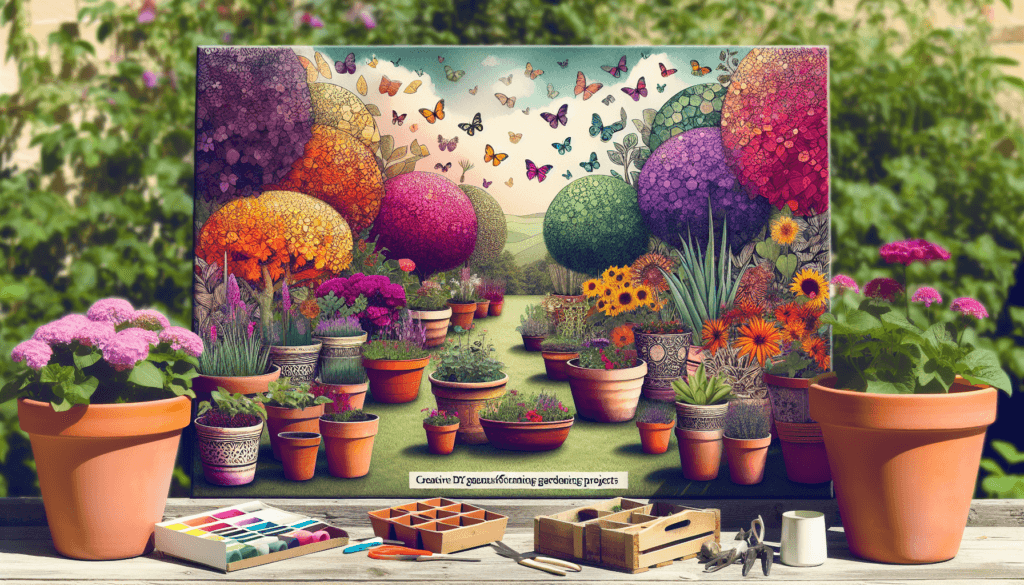Transforming your garden doesn’t have to be an expensive or time-consuming endeavor. With the top DIY projects at your fingertips, you can effortlessly create a stunning outdoor oasis that reflects your personal style and brings joy to your daily life. From unique planters to charming garden decor, this article will guide you through the top ways to transform your garden into a tranquil and captivating space that you can proudly call your own. So roll up your sleeves, grab your tools, and let’s get ready to bring your garden dreams to life!

Creating a Beautiful Garden Path
Choosing the Right Materials
When it comes to creating a beautiful garden path, choosing the right materials is essential. You have several options to consider, such as gravel, pavers, or stepping stones. Gravel is a cost-effective choice that provides a natural and rustic look. Pavers offer durability and can be arranged in various patterns, allowing you to get creative with your pathway design. Stepping stones, on the other hand, add a whimsical touch to your garden and can be easily customized to fit your desired aesthetic.
Preparing the Pathway
Before you start laying your garden path, it’s important to prepare the pathway properly. Clear away any vegetation or debris from the area where the path will be located. If the ground is uneven, you may need to level it by adding or removing soil. Ensure that the pathway is wide enough to comfortably walk on and consider the flow of traffic through your garden. It’s also a good idea to mark the edges of the pathway with string or stakes to guide your installation process.
Laying the Path
Now that you’ve chosen your materials and prepared the pathway, it’s time to lay your garden path. If you opt for gravel, start by spreading a layer of landscape fabric on the cleared pathway. This will help prevent weeds from growing through the gravel. Then, evenly distribute the gravel over the fabric and use a tamper to compact it. Pavers and stepping stones require a slightly different approach. Begin by digging a shallow trench for each stone, ensuring they are level with the surrounding ground. Fill the gaps between the stones with sand or pea gravel to provide stability.
Adding Finishing Touches
To complete your beautiful garden path, consider adding some finishing touches. You can edge the pathway with decorative stones or bricks to create a defined border. This not only enhances the aesthetic appeal but also helps prevent the path from shifting over time. Adding plants, such as low-growing groundcover or colorful flowers, along the edges of the path can further enhance its beauty. Additionally, installing outdoor lighting along the path will not only make it safe to navigate at night but also create an enchanting ambiance in your garden.
Building a Customizable Garden Shed
Determining the Shed’s Purpose
Before you begin building a garden shed, it’s important to determine its purpose. Will it be used primarily for storing gardening tools and equipment? Or do you plan on using it as a workshop or a space for relaxation and hobbies? Understanding the shed’s intended use will help you determine its size, design, and layout. It’s also essential to check your local building codes and obtain any necessary permits before starting construction.
Designing the Shed
Designing your garden shed allows you to make it truly customizable to your specific needs and preferences. Consider the layout of the interior, such as the number and size of windows, the placement of doors, and the inclusion of shelves or workbenches. You can choose between different architectural styles like traditional, modern, or rustic to complement the overall aesthetics of your garden. Take into account the climate of your area to ensure the shed is well-insulated and equipped to withstand the elements.
Gathering the Necessary Materials
Once you have finalized your shed design, it’s time to gather the necessary materials. This may include lumber, nails, screws, roofing materials, and windows, among other things. Determine the quantity and quality of each item based on your design specifications. It’s important to choose materials that are durable and suitable for outdoor use. Consider incorporating sustainable materials or repurposing old materials to reduce your environmental impact.
Constructing the Shed
Constructing a garden shed requires careful planning and attention to detail. Start by laying the foundation, which can be a concrete slab, pier blocks, or a gravel base, depending on your preference and the size of the shed. Follow your shed design plans and ensure that each piece of lumber is securely fastened together. Take your time to measure and cut the materials accurately to ensure a proper fit. As you progress, regularly check for squareness and make any necessary adjustments.
Customizing the Interior and Exterior
After completing the construction of your garden shed, it’s time to focus on customizing the interior and exterior. Paint or stain the exterior walls to protect the wood and enhance the shed’s appearance. Consider adding windows or skylights to bring in natural light. Inside the shed, you can install shelves, pegboards, or hooks to help organize your tools and equipment. Don’t forget to add personal touches such as decorations or artwork to make your shed a pleasant and functional space.

Constructing Vertical Gardens
Selecting a Suitable Location
When constructing a vertical garden, choosing the right location is crucial. Consider the amount of sunlight the area receives throughout the day and the specific sunlight requirements of the plants you intend to grow. Ensure that the location provides proper drainage to prevent waterlogging. Vertical gardens can be installed on fences, walls, or freestanding structures, such as trellises or frames. Ensure that the selected location can support the weight of the vertical garden and that it is easily accessible for maintenance.
Choosing the Right Plants
Selecting the right plants for your vertical garden is essential for its success. Consider the specific growing conditions in your chosen location, such as sunlight, temperature, and humidity. Opt for plants that are suitable for vertical growth, such as vines, ivy, or certain types of herbs and vegetables. Choose a variety of plants with different colors, textures, and heights to create an interesting and visually appealing display. Additionally, consider the maintenance requirements of each plant to ensure you can provide the necessary care.
Building the Support Structure
The support structure is a key component of constructing a vertical garden. This structure provides stability and holds the plants in place as they grow. Depending on your chosen location, you can use trellises, wire mesh, pallets, or even repurposed materials like old ladders or window frames. The support structure should be securely mounted or anchored to ensure its stability. Consider spacing between the support elements to allow sufficient room for plant growth and provide easy access for pruning or harvesting.
Planting and Maintaining the Vertical Garden
Once you have built the support structure, it’s time to start planting your vertical garden. Begin by preparing the soil or planting medium, ensuring it is well-draining and nutrient-rich. Plant the selected plants according to their recommended spacing and depth, taking care not to damage the roots. Water the plants thoroughly after planting and monitor their moisture levels regularly, adjusting the watering accordingly. As the plants grow, provide support or guide them along the structure to encourage upward growth. Regularly prune or trim the plants to maintain their shape and prevent overcrowding.
Creating a Relaxing Outdoor Lounge
Designing the Lounge Area
Designing a relaxing outdoor lounge requires careful consideration of the space and your desired atmosphere. Determine how you plan to use the lounge area – whether it’s for entertaining guests, lounging with a book, or enjoying meals outdoors. Consider factors such as seating arrangements, pathways, and the overall flow of the space. Identify a focal point, such as a fire pit or a water feature, to enhance the ambiance. Sketch out your design ideas and experiment with different layouts to find the most optimal arrangement.
Selecting Comfortable Furniture
Comfortable furniture is essential for creating a relaxing outdoor lounge. Opt for seating options that offer both comfort and durability, such as weather-resistant sofas, lounge chairs, or hammocks. Cushions and pillows can add an extra level of coziness and can easily be switched out to match different seasons or color schemes. Consider the materials of the furniture to ensure they can withstand outdoor elements and are easy to clean and maintain.
Adding Cozy Lighting
Cozy lighting plays a crucial role in creating a relaxing ambiance in your outdoor lounge. Choose a variety of lighting options to provide different levels of illumination throughout the space. String lights can be draped along fences or pergolas to create a soft and enchanting glow. Lanterns, candles, or solar-powered pathway lights can provide a warm and intimate atmosphere. Consider adding dimmer switches to control the intensity of the lighting and create different moods depending on the occasion.
Incorporating Shade and Privacy
To ensure comfort and privacy in your outdoor lounge, it’s important to incorporate shade elements. This can include installing a pergola, canopy, or sunshade sail to provide relief from direct sunlight. Additionally, consider using outdoor curtains or privacy screens to define your lounge area and shield it from prying eyes. Shade sails and umbrellas can also be used to create designated areas for different activities within your outdoor lounge, such as dining or relaxation zones.
Accessorizing with Plants and Decor
The final finishing touches of your outdoor lounge include incorporating plants and decor. Choose plants that thrive in your climate and provide a lush and vibrant backdrop to your lounge area. Hanging baskets, potted plants, or vertical gardens can be used to add pops of color and greenery. Consider adding decorative elements such as sculptures, water features, or wind chimes to enhance the overall aesthetics. Outdoor rugs, throw pillows, and blankets can also be used to create a cozy and inviting atmosphere.

Building Raised Garden Beds
Choosing the Right Location
When building raised garden beds, selecting the right location is crucial for the success of your plants. Look for an area that receives ample sunlight throughout the day and has good air circulation. Avoid places with excessive shade or areas prone to waterlogging. Consider the convenience of the location as well – it should be easily accessible for watering, weeding, and harvesting. Take into account the size and layout of your garden to ensure the raised beds fit harmoniously into the overall design.
Determining the Size and Shape
The size and shape of your raised garden beds are determined by factors such as available space, garden layout, and your planting goals. Ensure the beds are narrow enough for easy access from all sides to avoid stepping on the soil. A width of 3 to 4 feet is typically recommended. The length and height can vary depending on your needs and preferences. Rectangular or square beds are common choices, but you can get creative with circular or curved shapes to add visual interest to your garden.
Preparing the Ground
Preparing the ground before constructing the raised garden beds is essential for the success of your plants’ growth. Clear away any existing vegetation, rocks, or debris from the area. Level the ground and remove any large clumps of soil or grass. Consider laying a barrier such as landscape fabric or cardboard to prevent weeds from infiltrating the raised beds. Prepare the pathways between the beds by covering them with mulch, gravel, or stepping stones for easy access and to prevent soil compaction.
Constructing the Raised Bed
Once the ground is prepared, it’s time to construct the raised garden beds. Start by assembling the frames using materials such as wood, bricks, or concrete blocks. Ensure the frames are sturdy and level. If using wood, choose untreated lumber or opt for rot-resistant varieties such as cedar or redwood. Secure the corners and any additional sides with screws or nails. Consider adding a bottom layer of wire mesh to prevent burrowing pests from accessing the beds.
Filling with Soil and Planting
After constructing the raised beds, it’s time to fill them with soil and start planting. Use a high-quality soil mix that is fertile, well-draining, and rich in organic matter. Avoid using soil from your garden, as it may contain pests or diseases. Fill the beds with soil up to a few inches below the top rim. Smooth the soil surface and create furrows or planting holes according to your desired plant spacing. Water the beds thoroughly before planting and continue to provide adequate moisture as the plants establish themselves.
Installing a Water Feature
Selecting the Right Type of Water Feature
Installing a water feature can enhance the tranquility and beauty of your garden. There are various options to choose from, such as a fountain, pond, or waterfall. Consider the size of your garden and the available space when selecting the right type of water feature. Fountains provide a soothing sound and can fit into smaller spaces, while ponds and waterfalls offer a larger-scale focal point. Think about the materials that best complement your garden’s aesthetics, such as stone, concrete, or metal.
Planning the Location and Design
Once you’ve decided on the type of water feature, careful planning of the location and design is necessary. Consider the position of the water feature in relation to your house and other elements in your garden. Ensure that it is easily visible and accessible from different angles. Take into account the water source – whether it will be connected to an existing water line or require a separate water supply. If you’re considering a pond, think about incorporating aquatic plants or fish to create a vibrant and balanced ecosystem.
Gathering the Necessary Supplies
Before you start installing the water feature, gather all the necessary supplies and equipment. This may include a water pump, tubing, pond liner, filters, and decorative elements such as rocks or plants. Ensure that you have the correct tools for the job, such as a shovel, level, and measuring tape. Depending on the complexity of the water feature, you may need to consult with a professional or purchase a water feature kit that includes all the required components.
Digging and Installing the Water Feature
Now it’s time to bring your water feature to life. Begin by marking the desired location and shape of the water feature using stakes and string. Excavate the area following the specific requirements of your chosen water feature. For ponds, dig a hole that is deep enough to accommodate the liner and create shelves or slopes for plants or decorative elements. Install the liner, ensuring it is level and smooth out any wrinkles. Connect the water pump and tubing, securing them in place. Start filling the water feature with water and adjust the flow and height of the fountain or waterfall as desired.
Adding Final Touches and Maintenance
After installing the water feature, it’s time to add the final touches and ensure its proper maintenance. Arrange decorative elements such as rocks, stones, or aquatic plants around the water feature to create a natural and serene environment. Consider adding lighting to highlight the water feature at night, creating a magical effect. Regularly monitor the water levels, cleanliness, and functionality of the pump or filtration system. Clean the water feature as needed, removing any debris or algae. Proper maintenance will ensure the longevity and beauty of your water feature.

Creating an Herb or Vegetable Garden
Choosing the Ideal Location
When creating an herb or vegetable garden, choosing the ideal location is essential for the success of your plants. Look for an area that receives at least 6 hours of direct sunlight per day. Avoid places with excessive shade or areas that are prone to strong winds. Consider the proximity to a water source for convenient watering. Take into account the accessibility and the size of the garden, ensuring you have enough space to grow a variety of herbs or vegetables.
Planning the Layout
Effective planning of the layout is crucial for optimizing the space in your herb or vegetable garden. Consider factors such as plant height, growth habits, and their compatibility when determining their placement. Place taller plants, such as tomatoes or trellised vegetables, on the northern side to avoid shading shorter plants. Plan for pathways between the beds or rows to provide easy access for planting, watering, and harvesting. Ensure that each herb or vegetable has adequate spacing to promote airflow and prevent overcrowding.
Preparing the Soil
Preparing the soil in your herb or vegetable garden is essential for creating a nutrient-rich environment for your plants. Start by clearing the area of any existing vegetation or weeds. Loosen the soil by tilling or digging it with a garden fork, breaking up any clumps or compacted areas. Consider incorporating organic matter, such as compost or well-rotted manure, into the soil to improve its structure and fertility. Level the soil surface and remove any rocks or debris that may hinder the growth of your plants.
Planting Herbs or Vegetables
Now that your soil is prepared, it’s time to start planting your chosen herbs or vegetables. Follow the recommended planting guidelines for each plant, considering factors such as depth, spacing, and watering requirements. If planting seeds, create furrows or individual holes to plant them in. Ensure that the soil is evenly moist during the planting process to aid in germination. If using young transplants, gently remove them from their containers and place them in the prepared soil, firming it gently around the roots.
Caring for and Harvesting the Garden
Caring for your herb or vegetable garden involves regular maintenance and attention to the needs of your plants. Water your garden regularly, ensuring the soil is consistently moist but not waterlogged. Mulching around the plants can help conserve soil moisture and prevent weed growth. Monitor your garden for pests or diseases and take appropriate measures to control them, whether through natural remedies or organic pesticides. Regularly harvest your herbs or vegetables, picking them at their peak flavor or when they reach the desired size. This will encourage continued production and prevent overcrowding in the garden.
Constructing a DIY Trellis
Selecting the Right Trellis Design
When constructing a DIY trellis, selecting the right design is essential to ensure proper support and aesthetics. Consider the type of plants you intend to grow and their growth habits. For vining plants, such as cucumbers or climbing roses, choose a trellis with wide gaps or sturdy wires for them to cling onto. If you prefer a more decorative approach, opt for trellis designs with intricate patterns or shapes. Take into account the available space, materials, and your own design preferences when making your selection.
Gathering the Materials
Once you have chosen the trellis design, gather the necessary materials for construction. The materials will depend on your chosen design, but commonly used options include wood, bamboo, or metal. Consider the durability and suitability of the materials for outdoor use, ensuring they can withstand the elements and support the weight of the plants. Depending on the design, you may need additional fasteners, such as screws or wire ties, to secure the trellis together.
Preparing the Site
Before installing the DIY trellis, prepare the site by removing any existing vegetation or debris. Ensure that the soil is adequately prepared and amend it with organic matter if necessary. Determine the optimal location for the trellis, considering factors such as sunlight exposure and the proximity to the plants you intend to support. If necessary, install any necessary support structures, such as posts or stakes, to anchor the trellis securely.
Building and Installing the Trellis
Now it’s time to build and install your DIY trellis. Start by constructing the frame according to your chosen design, ensuring that it is sturdy and level. Depending on the design, you may need to pre-drill holes or cut notches for easier assembly. If using multiple sections, securely join them together using screws or wire ties. Once the trellis is built, carefully position it in the designated location and attach it to the support structures. Double-check that the trellis is level and adjust if necessary.
Training Plants on the Trellis
After installing the trellis, it’s important to train the plants to grow on it properly. For vining plants, guide the main stems or tendrils towards the trellis, gently tying them in place if necessary. Periodically check for new growth and redirect it towards the trellis. As the plants continue to grow, continue to secure them to the trellis, ensuring they are well-supported and have room to spread. Regularly prune or trim the plants to maintain their shape and prevent overcrowding on the trellis.

Designing a Charming Garden Fence
Selecting the Fence Style and Materials
Designing a charming garden fence involves selecting the right style and materials that complement your garden aesthetics. Consider the overall theme or concept of your garden and choose a fence style that harmonizes with it. Options include rustic wooden fences, elegant wrought iron fences, or modern metal mesh fences. Select materials that are durable, weather-resistant, and suited to your desired level of maintenance. If privacy is a concern, choose a fence style with solid panels or install plants or trellises to create a living fence.
Measuring and Planning the Fence
Before building and installing the garden fence, accurate measurements and detailed planning are essential. Measure the perimeter of the area where the fence will be installed and determine the required height. Sketch out a layout of your garden, indicating the location of existing plants, structures, or pathways. Plan for fence gates or entrances to provide easy access to your garden. Consider any slope or irregularities in the terrain and plan how the fence will address these challenges.
Preparing the Area
Prepare the area where the garden fence will be installed by clearing away any vegetation or debris. Remove rocks or roots that may obstruct the fence installation process. Level the ground and ensure it is firm and stable. If necessary, mark the location of the fence posts using stakes and string, ensuring that they are evenly spaced. Consider including post holes or concrete footings for added stability. Additionally, determine any additional materials or tools you may need, such as concrete, screws, or nails.
Building and Installing the Fence
Now it’s time to begin building and installing your garden fence. Start by installing the fence posts, ensuring they are plumb and securely anchored in the ground or concrete footings. Attach the fence panels or rails to the posts, ensuring they are level and evenly spaced. Depending on the style and design, you may need to cut or trim the panels to fit the desired length or shape. If using wooden materials, treat them with a weather-resistant coating or paint to prolong their lifespan.
Adding Finishing Touches
To create a charming and cohesive garden fence, consider adding some finishing touches. Paint or stain the fence panels with colors that complement your garden or home’s exterior. Incorporate decorative elements, such as finials or lattice inserts, to add visual interest and personality. Additionally, consider planting climbing vines or flowers along the fence to create a beautiful backdrop and enhance the overall aesthetics of your garden. Regularly inspect and maintain the fence, ensuring any damage is promptly repaired to prolong its lifespan.
Creating a DIY Garden Fire Pit
Choosing the Ideal Fire Pit Location
When creating a DIY garden fire pit, choosing the ideal location is crucial for safety and enjoyment. Select a location away from any overhanging trees, structures, or flammable materials. Ensure that the distance from the fire pit to surrounding objects is sufficient to prevent accidents and minimize fire risk. Consider the wind patterns in your garden and the prevailing winds in your area when determining the fire pit location. It’s also important to check your local regulations or fire codes regarding outdoor fire pit installations.
Determining the Fire Pit Size and Design
The size and design of your garden fire pit will depend on your needs and available space. Determine the optimal size by considering the number of people you intend to accommodate and the primary use of the fire pit – whether it’s for cozy gatherings or cooking. Common shapes for fire pits include circular, square, or rectangular. Choose a design that complements your garden aesthetics and ensure it is made of fire-resistant materials such as stone, brick, or metal.
Digging and Preparing the Pit
Once you’ve determined the location and design of your fire pit, it’s time to dig and prepare the pit. Start by marking the perimeter of your desired fire pit using stakes and string. Dig a hole that is slightly larger than the intended size of the fire pit, ensuring you reach a depth of approximately one foot. Remove any vegetation or debris from the pit and level the bottom. Consider lining the pit with fire-resistant materials such as fire bricks or concrete blocks for added protection.
Constructing the Fire Pit
After preparing the pit, it’s time to construct your DIY garden fire pit. Begin by placing a layer of gravel or sand in the bottom of the pit to promote proper drainage. If using fire bricks or concrete blocks, arrange them in the desired pattern, ensuring they are tightly placed together. If using stone or brick, secure the pieces using mortar or a heat-resistant adhesive. Double-check that the stones or bricks are level and stable as you progress. Pay attention to the inner diameter and height of the fire pit, ensuring it is suitable for your intended use.
Adding Safety Features and Enjoying the Fire Pit
To ensure safety while enjoying your garden fire pit, it’s important to incorporate certain features. Install a fire pit screen or spark guard to prevent sparks and embers from escaping the pit. Consider including a grate or grill for cooking purposes if desired. Place a fire extinguisher or a bucket of water nearby for emergencies. Additionally, provide comfortable seating around the fire pit and consider adding storage for firewood or other essentials. Once all safety features are in place, you can start enjoying the warmth and ambiance of your garden fire pit while practicing proper fire safety guidelines.


